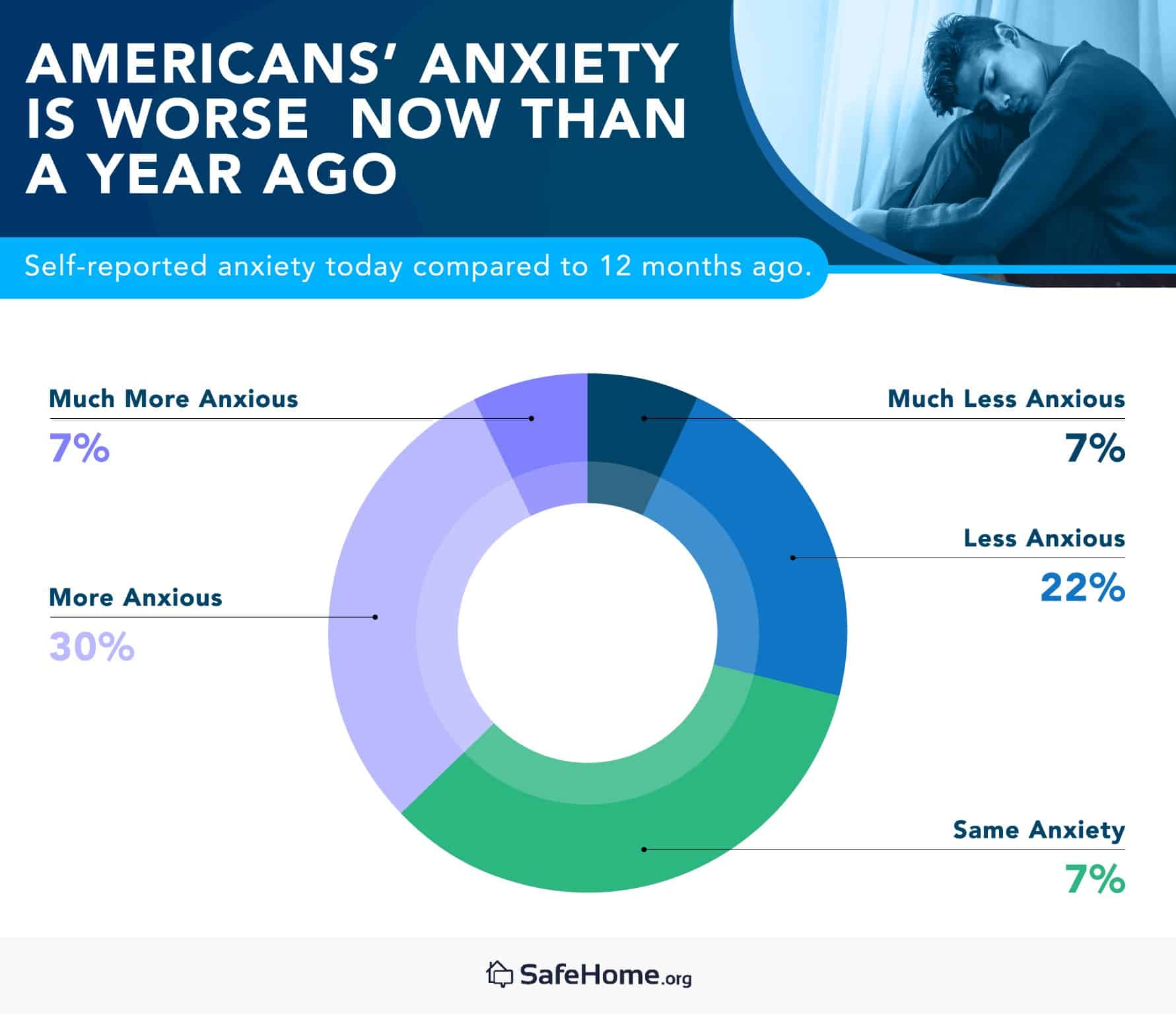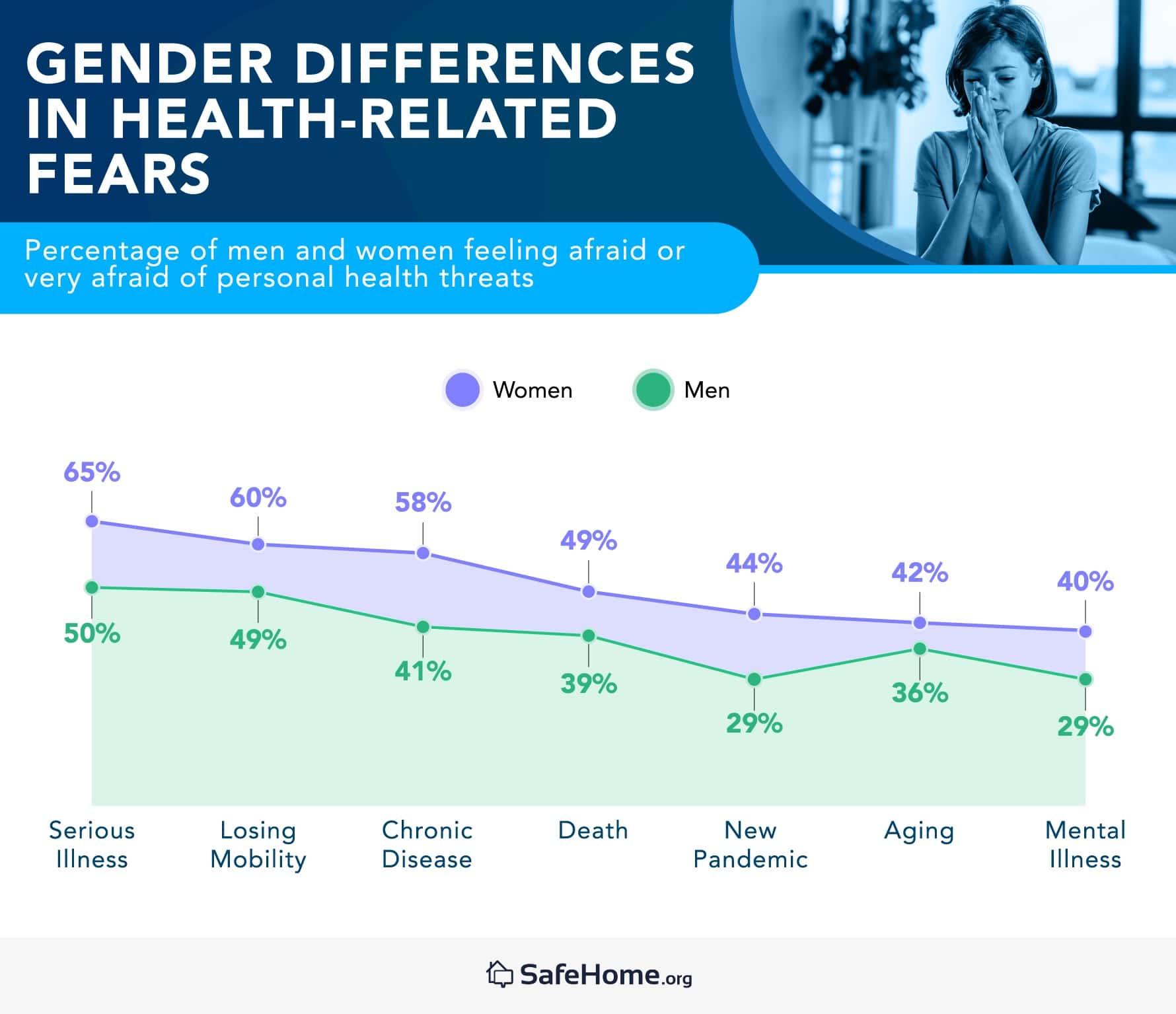What Americans Fear Most: 2023 Fear Ranking
As Halloween approaches, the real world feels scarier than ever for many Americans – economic uncertainty, renewed conflict in Israel and Gaza, and a looming presidential election add to their everyday concerns.
Since we conducted our first fear study in 2021, year-over-year anxiety has only risen in the United States. This year, we’ve set out to identify what’s driving these growing fears by polling over 2,000 adults:
Americans’ Top 10 Fears, 2023
- Loved ones dying
- Loved ones becoming seriously ill
- Personally becoming seriously ill
- Not having enough money for retirement
- Mass shootings/gun violence
- Losing physical mobility
- Corrupt government officials
- Chronic diseases
- High medical bills
- U.S. getting involved in another world war
Here are a few other key takeaways from the research:
- Four in ten Americans report their anxiety has worsened over the past year.
- As a nation, our greatest fears concern those closest to us: more than two-thirds of adults fear their loved ones becoming sick or dying.
- 46% of Americans fear the U.S. entering another world war, making this scenario one of the top 10 most concerning.
- 55% of Americans are afraid they won’t have enough money for retirement, and 54% are afraid of gun violence and mass shootings.
- The prospect of Donald Trump returning to the presidency is America’s #12 overall greatest fear: 47% of Americans fear this outcome. The re-election of Joe Biden ranked much lower at 47th place.
The Year in Fear 2023: An Overview
We conducted our first fear ranking in 2021, following the most stressful year on record. Though society's descent into sadness has slowed, it has not yet reversed. Studies show a plateau in global unhappiness, stalling despair at critical levels. Unfortunately, we found that year-over-year anxiety remains dire in the United States.
When we asked Americans to describe their anxiety level compared to one year ago, 37 percent declared it had worsened, compared to only 29 percent citing improvement. Roughly one-third said that their anxiety remained constant from 2022 to 2023.
This anxiety change was nearly identical among men and women but varied noticeably along a generational divide. Younger Americans experienced worsening anxiety: almost half of those under age 45 said they were more anxious in 2023, compared to less than one-third of those aged 46 and older.
To understand which concerns fuel America's anxiety, we asked participants to disclose how much they fear 72 unique situations across several general categories. After adjusting results to ensure an accurate representation of the population, we calculated “fear scores” to quantify the collective fear associated with each subject. Scenarios with higher scores (closer to 100) indicate more people were afraid, and situations scores closer to zero were less frightening for our respondents.
Political Fears: Global Conflict and 2024 Elections Driving Anxiety
In an ideal world, politics can be a positive societal force rather than a source of suspicion. Unfortunately, in this moment of stark polarization political issues sow distrust among neighbors. This political divide and upcoming presidential election may be driving deep-seated worries according to our study:
| Political fears | Fear score | Percent of people feeling afraid or very afraid of situation |
|---|---|---|
| Corrupt government officials | 78 | 52% |
| U.S. getting involved in another world war | 74 | 46% |
| Trump being re-elected as president | 71 | 47% |
| Corporations influencing government | 71 | 45% |
| Widespread civil unrest | 66 | 40% |
| Terrorism | 63 | 36% |
| Restriction of women's rights | 61 | 41% |
| Increasing national debt | 60 | 36% |
| Government tracking your personal data/spying | 59 | 35% |
| Fascism | 58 | 36% |
| Biden being re-elected as president | 50 | 31% |
| Racism | 49 | 29% |
| Communism | 39 | 22% |
| Illegal immigration into the U.S. | 36 | 20% |
| Firearm restrictions | 30 | 18% |
| Transgender rights initiatives | 23 | 14% |
The looming presidential election intensifies political tensions, with a likely Biden-Trump rematch in 2024. Donald Trump's potential return to office ranks as the nation's #12 overall fear, particularly worrying women, older Americans, and those in urban communities. While people are concerned about both leading candidates, a higher proportion of Americans fear Trump’s re-election compared to Biden’s.
The threat of world war also sparked fear in 46 percent of American adults. As war between Russia and U.S. ally Ukraine drags on, recent renewed violence between Israel and Gaza may add to Americans’ anxiety surrounding global warfare.
True Crime: Mass Shootings and Civil Unrest Remain Front-of-Mind
Urban crime rates are higher today than before the pandemic. In 2022, high-profile active shooter incidents surged, and school shootings increased in 2023. Our findings reflect these realities: gun violence was the 5th scariest situation in our ranking, with 54 percent of Americans expressing fear about this threat. Identity theft and robbery were other crimes with fear scores in the 60s.
| Crime fears | Fear score | Percent of people feeling afraid or very afraid of situation |
|---|---|---|
| Mass shootings/gun violence | 83 | 54% |
| Identity theft | 60 | 34% |
| Robbery or burglary | 60 | 34% |
| Being physically assaulted | 56 | 33% |
| Walking alone at night | 55 | 32% |
| Hate crimes | 54 | 32% |
| Credit card fraud | 53 | 28% |
| Police brutality | 52 | 31% |
| Being sexually assaulted | 46 | 28% |
Gender disparities play a significant role in fear rankings, with twice as many women fearing physical assault, three times as many fearing sexual assault, and four times as many worrying about walking alone at night compared to men.
| Crime fear scores, by community setting | Urban dwellers average fear score | Rural dwellers average fear score |
|---|---|---|
| Mass shootings/gun violence | 91 | 76 |
| Hate crimes | 69 | 47 |
| Police brutality | 68 | 47 |
| Being physically assaulted | 67 | 52 |
| Robbery or burglary | 66 | 56 |
| Walking alone at night | 63 | 51 |
| Credit card fraud | 61 | 46 |
| Being sexually assaulted | 57 | 41 |
Different community settings also produced a recognizable divide. The violent crime rate in urban environments is more than twice as high as in rural areas, leaving city-dwelling Americans justifiably more frightened of victimization. In particular, gun violence, hate crimes, and police brutality generated significantly higher fear scores among Americans in urban locations.
Personal Health: A Near-Universal Fear Following Covid-19
The unpredictable possibility of our bodies betraying us is a common human concern, as indicated by three personal health fears landing in the top 10 fears.
Becoming seriously ill is Americans’ third most prevalent fear. Losing physical mobility and contracting a chronic illness were also highly-ranked anxieties. Additionally, dying, getting old, and the chance of another pandemic all posted fear scores in the 60s.
| Personal health fears | Fear score | Percent of people feeling afraid or very afraid of situation |
|---|---|---|
| Personally becoming seriously ill | 86 | 57% |
| Losing physical mobility | 82 | 54% |
| Chronic diseases | 75 | 50% |
| Dying | 69 | 44% |
| Getting old | 62 | 39% |
| Another pandemic like COVID-19 | 62 | 37% |
| Mental illness | 57 | 35% |
Men and women demonstrated similar rankings regarding matters of personal health, but women’s fear ran deeper. The percentage of women afraid of individual health threats was more significant than that of men on every issue.
Assessing health-related fears by age group reveals that older Americans closer to life’s natural end appear more accepting of death. Youngsters may act invincible, but those under 30 are far more frightened of their mortality than those in the oldest age groups.
We also learned that urban communities are demonstrably more anxious about the possibility of another pandemic. Nearly half of urban dwellers were afraid of a new pandemic, compared to around 30 percent of rural residents. This finding may have philosophical roots, as rural communities tend to be more conservative and skeptical of public health initiatives. Alternatively, the disparity could be based on practical concerns, as communicable diseases can spread more quickly in densely populated areas.
Climate Concerns: Environmental Issues Inspire Widespread Fear
With polluted air covering every country, freshwater shortages on the horizon, and experts warning of an approaching threshold for catastrophic climate change, pervasive fears of such global threats are well-grounded in reality.
None of these fears cracked the top ten. Still, several environmental, ecological, and disaster-based fears produced fear scores of 60 or higher, with pollution, climate change, and natural disasters leading the way.
| Environmental fears | Fear score | Percent of people feeling afraid or very afraid of situation |
|---|---|---|
| Pollution in oceans, rivers, and lakes | 69 | 43% |
| Climate change | 68 | 44% |
| Natural disasters | 65 | 38% |
| Extinction of plants and animals | 64 | 40% |
| Losing access to clean water | 60 | 37% |
| Air pollution | 60 | 36% |
| Losing home to a natural disaster | 59 | 36% |
| Plastic waste | 46 | 25% |
| Asteroid impact | 28 | 14% |
As threats to the planet affect every demographic, these fears were broadly equal among genders and age groups. Respondents in urban areas, however, reported far greater fear about environmental and ecological concerns. These positions may be driven by politics more than population density, as Republicans significantly outnumber Democrats in rural America and generally consider the environment a lower priority. Among fears of natural disasters, an asteroid impact was the lowest-ranked global threat (befitting the low level of risk).
Conclusion
In recent years, Americans have been exposed to innumerable sources of legitimate fear, from gun violence and viruses to political strife and a string of natural disasters. Adding in the challenges of daily existence and magnifying it all via social media doom-scrolling produces a proven recipe for elevated anxiety.
Yet despite all this turmoil, almost one-third of the country felt less anxious than 12 months ago, proving that darkness is not all-encompassing and hope remains for us all.
If you or a loved one needs help facing these kinds of fears, you’re not alone. Find mental health resources and get help today by visiting the Substance Abuse and Mental Health Services Administration (SAMHSA) website.
Our Data and Complete Fear Rankings
Safehome.org conducted an online poll of 2,634 adults living in the U.S. about the degree to which they fear various scenarios. Respondents were weighted according to the 2020 U.S. Census so their responses were representative of the American population in terms of gender and age.
Fears were ranked by two metrics: The percentage of respondents who were afraid or very afraid of each scenario, and by a fear score. The fear score is a normalized weighted sum whereby “Very afraid” was weighted 3, “Afraid” was weighted 2, “Slightly afraid” was weighted 1, and “Not afraid” was weighted at 0. The number of responses for each is multiplied by their weight and summed together, then normalized by dividing by two times the total number of responses, then multiplied by 100 and rounded to the nearest integer.
| Rank | Scenario | Fear score | Percentage of respondents feeling afraid or very afraid |
|---|---|---|---|
| 1 | Loved ones dying | 99 | 68% |
| 2 | Loved ones becoming seriously ill | 98 | 68% |
| 3 | Personally becoming seriously ill | 86 | 57% |
| 4 | Not having enough money for retirement | 83 | 55% |
| 5 | Mass shootings/gun violence | 83 | 54% |
| 6 | Losing physical mobility | 82 | 54% |
| 7 | Corrupt government officials | 78 | 52% |
| 8 | Chronic diseases | 75 | 50% |
| 9 | High medical bills | 74 | 48% |
| 10 | U.S. getting involved in another world war | 74 | 46% |
| 11 | Car crash | 72 | 45% |
| 12 | Trump being re-elected as president | 71 | 47% |
| 13 | Corporations influencing government | 71 | 45% |
| 14 | Pollution in oceans, rivers, and lakes | 69 | 43% |
| 15 | Dying | 69 | 44% |
| 16 | Climate change | 68 | 44% |
| 17 | Being unable to pay rent/mortgage | 68 | 44% |
| 18 | House fire | 67 | 40% |
| 19 | Widespread civil unrest | 66 | 40% |
| 20 | Natural disasters | 65 | 38% |
| 21 | Being hit by a drunk driver | 65 | 38% |
| 22 | Extinction of plants and animals | 64 | 40% |
| 23 | Terrorism | 63 | 36% |
| 24 | Getting old | 62 | 39% |
| 25 | Another pandemic like COVID-19 | 62 | 37% |
| 26 | Snakes | 62 | 38% |
| 27 | Never paying off debt | 61 | 40% |
| 28 | Public speaking | 61 | 36% |
| 29 | Restriction of women's rights | 61 | 41% |
| 30 | Losing access to clean water | 60 | 37% |
| 31 | Increasing national debt | 60 | 36% |
| 32 | Air pollution | 60 | 36% |
| 33 | Identity theft | 60 | 34% |
| 34 | Robbery or burglary | 60 | 34% |
| 35 | Losing home to a natural disaster | 59 | 36% |
| 36 | Government tracking your personal data/spying | 59 | 35% |
| 37 | Fascism | 58 | 36% |
| 38 | Mental illness | 57 | 35% |
| 39 | Being physically assaulted | 56 | 33% |
| 40 | Walking alone at night | 55 | 32% |
| 41 | Hate crimes | 54 | 32% |
| 42 | Being falsely accused of a crime | 54 | 33% |
| 43 | Credit card fraud | 53 | 28% |
| 44 | Being misunderstood by loved ones | 52 | 29% |
| 45 | Plane crash | 52 | 29% |
| 46 | Police brutality | 52 | 31% |
| 47 | Biden being re-elected as president | 50 | 31% |
| 48 | Racism | 49 | 29% |
| 49 | Spiders | 47 | 26% |
| 50 | Being stuck in an elevator | 47 | 26% |
| 51 | Stock market crash | 46 | 24% |
| 52 | Plastic waste | 46 | 25% |
| 53 | Losing your job | 46 | 31% |
| 54 | Being sexually assaulted | 46 | 28% |
| 55 | Being alone | 46 | 27% |
| 56 | A.I./artificial intelligence | 45 | 22% |
| 57 | Unfaithful partner | 44 | 28% |
| 58 | Communism | 39 | 22% |
| 59 | Lightning strikes | 38 | 20% |
| 60 | Illegal immigration into the U.S. | 36 | 20% |
| 61 | Affording tuition costs for myself or a family member | 35 | 21% |
| 62 | Needles / Injections | 34 | 18% |
| 63 | Shark attack | 33 | 20% |
| 64 | Workplace automation | 32 | 16% |
| 65 | Being the victim of domestic abuse | 32 | 20% |
| 66 | Firearm restrictions | 30 | 18% |
| 67 | Relationships lost because of political/social differences | 30 | 16% |
| 68 | Asteroid impact | 28 | 14% |
| 69 | Transgender rights initiatives | 23 | 14% |
| 70 | Ghosts | 20 | 10% |
| 71 | Zombie Apocalypse | 19 | 12% |
| 72 | Abduction by aliens | 14 | 8% |


